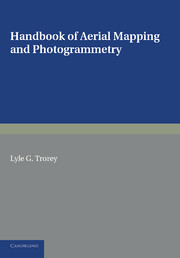Book contents
- Frontmatter
- Dedication
- FOREWORD
- PREFACE
- Contents
- LIST OF TABLES
- Bibliography
- Notation
- CHAPTER 1 PERSPECTIVE PRINCIPLES
- CHAPTER 2 MEASUREMENT OF ANGLES FROM OBLIQUES
- CHAPTER 3 PERSPECTIVE GRID AND FOUR-POINT METHODS
- CHAPTER 4 MEASUREMENT OF HEIGHT FROM A SINGLE OBLIQUE
- CHAPTER 5 VERTICALS: FUNDAMENTAL CONSIDERATIONS OF COVER, PARALLAX AND STEREOSCOPY
- CHAPTER 6 PARALLAX AND ELEVATION CALCULATIONS
- CHAPTER 7 RADIAL-LINE TRIANGULATIONS, GRAPHICAL AND MECHANICAL
- CHAPTER 8 RECTIFICATION MEANS
- CHAPTER 9 SUBDIVISIONS OF AN AIR SURVEY MAPPING OPERATION
- CHAPTER 10 PRINCIPLES OF STEREOSCOPIC PLOTTING INSTRUMENTS
- CHAPTER 11 THE MULTIPLEX PROJECTOR
- APPENDIX 1 STANDARD MAPPING PROCEDURE ROYAL CANADIAN ENGINEERS
- APPENDIX 2 MULTIPLEX AND STEREOPLANIGRAPH: CONSIDERATIONS GOVERNING MINIMUM CONTOUR INTERVAL
- APPENDIX 3 THE KELSH PLOTTER
- INDEX
CHAPTER 11 - THE MULTIPLEX PROJECTOR
Published online by Cambridge University Press: 05 June 2016
- Frontmatter
- Dedication
- FOREWORD
- PREFACE
- Contents
- LIST OF TABLES
- Bibliography
- Notation
- CHAPTER 1 PERSPECTIVE PRINCIPLES
- CHAPTER 2 MEASUREMENT OF ANGLES FROM OBLIQUES
- CHAPTER 3 PERSPECTIVE GRID AND FOUR-POINT METHODS
- CHAPTER 4 MEASUREMENT OF HEIGHT FROM A SINGLE OBLIQUE
- CHAPTER 5 VERTICALS: FUNDAMENTAL CONSIDERATIONS OF COVER, PARALLAX AND STEREOSCOPY
- CHAPTER 6 PARALLAX AND ELEVATION CALCULATIONS
- CHAPTER 7 RADIAL-LINE TRIANGULATIONS, GRAPHICAL AND MECHANICAL
- CHAPTER 8 RECTIFICATION MEANS
- CHAPTER 9 SUBDIVISIONS OF AN AIR SURVEY MAPPING OPERATION
- CHAPTER 10 PRINCIPLES OF STEREOSCOPIC PLOTTING INSTRUMENTS
- CHAPTER 11 THE MULTIPLEX PROJECTOR
- APPENDIX 1 STANDARD MAPPING PROCEDURE ROYAL CANADIAN ENGINEERS
- APPENDIX 2 MULTIPLEX AND STEREOPLANIGRAPH: CONSIDERATIONS GOVERNING MINIMUM CONTOUR INTERVAL
- APPENDIX 3 THE KELSH PLOTTER
- INDEX
Summary
The Instrument and its Ancillary Equipment
General Description. This description has particular reference to the Williamson-Ross SP-3 equipment, but in general is also applicable to the instruments of Zeiss and of Bausch and Lomb. The instrument consists of a number of projectors, miniature replicas of the aircraft camera, mounted on a bar supported at a suitable height from the plotting table, an accurately plane surface. Each projector has six degrees of freedom of motion.
The tracing table consists of a 4½ in. enamel disk bearing the floating mark. The disk is movable vertically through a range of 100 mm. by means of a thumb wheel engaging a vertical threaded column. A vernier reading to tenths of millimetres measures the height of the horizontal disk above datum. A pencil is provided to record the motion of the plotting table as it traces detail or a contour. The projection lamp operates at 24 V., and means are provided to control the intensity of illumination at each projection in use.
In operation, a blue filter is placed in one projector, and a red filter on the other of the pair—thus a blue image and a red image appear on the screen. Viewing these images with red and blue spectacles, the operator sees a stereoscopic model in the ordinary way. Viewing the model in this manner, as the table is raised or lowered, the mark will be seen to rise or fall with relation to the model.
Setting up consists in removing want of correspondence at the six points, in accordance with the drill given in the preceding chapter. In the previous discussion of want of correspondence the use of a floating cross to detect K was explained. The same principle finds application in the multiplex, but in this case a single cross floats above a real model. However, in the same way, minute differences in y may be detected. The arms of the cross are made to appear coplanar and delicate setting is possible (see fig. 74). If the left and centre crosses be fused, the N.W. arm appears to be above the N.E. arm, while if the centre and right crosses are fused the effect is reversed.
The assembly is shown diagrammatically in fig. 75, and fig. 76 is from a photograph of the instrument.
- Type
- Chapter
- Information
- Handbook of Aerial Mapping and Photogrammetry , pp. 131 - 147Publisher: Cambridge University PressPrint publication year: 2013



